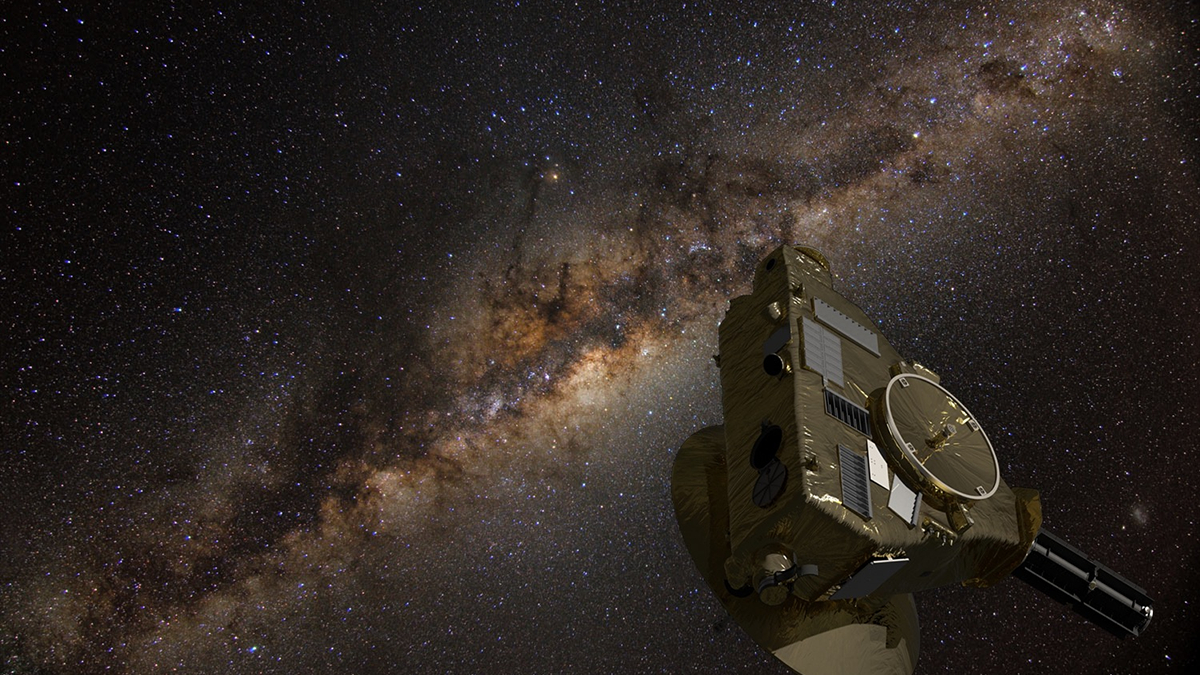Just how dark is the universe? NASA's New Horizons probe gives us best estimate yet
'If you hold up your hand in deep space, how much light does the universe shine on it?'

Space looks black, but just how dark is it?
It's a deceptively simple question that has puzzled astronomers since the 1960s. Now, thanks to data from NASA's New Horizons probe, they have arrived at the best-yet estimate of how dark — or rather, bright — deep space is: 100 billion times dimmer than the sunlight we see on Earth.
That's the amount of ambient, universe-permating glow from the births and deaths of trillions of galaxies and their countless stars ever resided in our universe. This vanishingly faint light is called the cosmic optical background (COB), and can be thought of as the visible equivalent of the cosmic microwave background (CMB) radiation, the light left over from the universe's creation.
"If you hold up your hand in deep space, how much light does the universe shine on it?" study lead author Marc Postman, an astronomer at the Space Telescope Science Institute in Baltimore, said in a statement. "We now have a good idea of just how dark space really is."
Precise measurements of the COB allows astronomers to study how and where galaxies and stars formed across the universe's 13.8-billion-year history. But the remnant glow is so imperceptible that even advanced telescopes struggle to distinguish it from unrelated light sources in the inner solar system, including sunlight scattered by the swarm of debris around Earth and countless specks of interplanetary dust.
"All attempts to measure the strength of the COB from the inner solar system suffer from large uncertainties," said study co-author Tod Lauer, an astronomer at the National Science Foundation's NOIRLab in Arizona.
New Horizons, however, zoomed past Pluto in July 2015 on its one-way trek out of the solar system and is now 5.5 billion miles (8.7 billion kilometers) from Earth — far enough away to witness the darkest possible "skies" and to collect the most accurate measurements to date of the faint background glow.
Breaking space news, the latest updates on rocket launches, skywatching events and more!
In the summer of 2023, the spacecraft scanned its surroundings using its onboard camera, gathering snapshots of two dozen pockets of the universe while pointing at high galactic latitudes, away from nearby bright stars and the Milky Way's blinding core. The probe's main body also shielded the sensitive camera such that even the dimmest sunlight couldn't directly reach it, according to the same statement.
While analyzing the probe's images, Lauer and his colleagues deducted light generated by dust in the halo that the Milky Way sits in, leaving them with a precise estimate of the cosmic optical background: roughly 11 nanowatts per square meter per a width of sky about 130 times the moon's diameter. The estimate is consistent with the number of galaxies formed since the Big Bang, the researchers say.
"Importantly, we also found that there is no evidence for significant levels of light produced by sources not presently known to astronomers," Postman said in the statement.
That's a relief to the researchers, whose initial estimates in 2021 suggested that the COB may be brighter than expected, leaving them to wonder whether there are any exotic, as-yet-undiscovered light sources contributing to the cosmic light.
"In our previous paper, we found there was as much light we couldn't account for as light we could measure," Postman told Astronomy.com. "The real 'gotcha' was that we simply weren't as familiar with the distribution of dust in the Milky Way as we should have been."
This time, the team was able to reference recent maps of galactic dust put together by the European Space Agency's Planck spacecraft and correct for the previously overestimated dust-scattered light.
"Looking outside the galaxies, we find darkness there and nothing more," Lauer said in the statement.
New Horizons, which is currently studying the little-explored Kuiper Belt in an extended mission mode, faced an uncertain future last August after NASA considered disbanding the mission's original science team, but agency officials later decided to continue the mission as-is for at least another five years, until 2028. Mission team members have said the probe has enough fuel to continue flying through at least 2040.
This research is described in a paper published Aug. 28 in The Astrophysical Journal.
Join our Space Forums to keep talking space on the latest missions, night sky and more! And if you have a news tip, correction or comment, let us know at: community@space.com.

Sharmila Kuthunur is a Seattle-based science journalist focusing on astronomy and space exploration. Her work has also appeared in Scientific American, Astronomy and Live Science, among other publications. She has earned a master's degree in journalism from Northeastern University in Boston. Follow her on BlueSky @skuthunur.bsky.social
-
Classical Motion There is no such thing as a real time measurement with starlight. The cosmos might be very dark and we not know it.Reply
